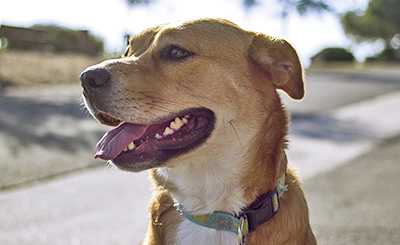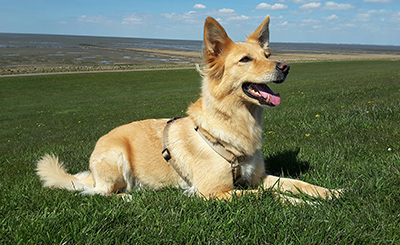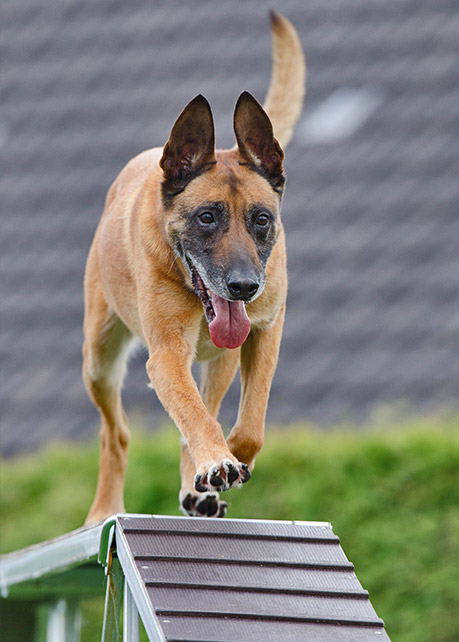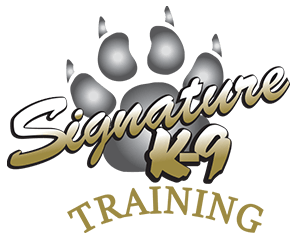
Selecting A Trainer
Signature K-9 Behavior & Training
Training Philosophy

Traditional:
Today’s trainers generally come from one of two orientation perspectives. One, I call traditional training. Traditional training methods have been used for at least 50 to 80 years. Most basic to traditional trainers is the idea that the dog should work for the owner because he is asked or commanded. Reinforcement is usually “good boy” or “good girl” sometimes accompanied by petting. Fundamental to this training philosophy is a reliance on ‘correction”, often done with a slip collar, also called a choke collar.

Contemporary:
A second orientation to training is what some call “all positive” training. This orientation uses positive motivation, in the form of food, play, attention, etc., to encourage behavior change. This approach minimizes use of traditional correction as a method to induce desired behavior.

Behaviorists:
You may also hear the term “behaviorist” or behavior consultant used in connection with training or behavior development programs. These terms often indicate that the individual involved uses a “scientific approach” to training and behavior work. That generally means that he or she has an understanding of Classical and Operant Conditioning as well as an awareness of animal behavior research which is used as a guide.

Finding the Training Plan For You
Some believe that, if training is even necessary, the only option is to attend a training class of 6 to 8 group lessons where a dog is taught obedience commands. For others, “dog training” represents a series of levels of classes. Each class is designed to teach more difficult concepts. Eventually, the owner and dog will be able to compete in dog shows or trials designed to showcase the dogs ability. For most of us, “dog training” is a means to develop a satisfying relationship with a loving companion. Over the last two decades, a great deal of research has been done which has changed both the methods available to trainers and the relationship basis for training… the humane element if you wish. These new methods have a profound impact on both training approaches and the environment while training takes place. There is no longer just one method. There are a variety of approaches which make trainers and behavior consultants more skillful in matching training strategies to the problems of the dog and the values of the owner. The cost of training depends on the amount of effort that the owner is willing and able to put forth. Make no mistake, good behavior does not occur without effort and behavior change for problem dogs requires even more. So, what are your choices? Options available allow you to select from a basic evaluation; or, you can participate in group classes, individual private lessons, invite a trainer to come to your home, or even send your dog away for in-kennel training. At Signature K-9 Training and Behavior LLC, if we don’t offer the service you want, we will recommend an appropriate resource. Following is a discussion of each of these options.
Behavior Evaluation
A behavior evaluation is usually done on an individual basis. The purpose of the evaluation is to match a training strategy with the dog’s behavior and the owner’s skills and values. This can help you decide on a type of training program or it can help you decide if you want to do all or part of the training yourself.
Group Classes
Group classes have been the most readily available. In a group class, you may pay ten to twelve dollars per session for six to eight sessions of approximately 50 minutes each. Instructors for these classes may come from two sources: Professional trainers, those who train to earn a living, and Club Trainers, those who train as a hobby. Credentials of trainers vary… see additional information about trainer credentials on this site. The advantage of group sessions is that a dog gets experience learning in a social environment. Help with individual problems and setting up the right structure at home is impossible because of time constraints. Signature K-9 offers several types and levels of small group classes (4 to 10 dogs) depending on skill and interest of dog and handler. To insure that the dog will benefit from a class, and be safe in a group, we start by working with the dog on an individual basis.
Private Lessons
Usually done individually, as a family, or with one or two people with similar problems and goals, private lessons offer an individualized approach. In private lessons, a dog’s individual problems can be diagnosed and strategies can be designed to manage or alleviate them. A structure for living in the human household can be established. Basic behavior commands or cues can be put in place and owners and family members are taught how to train their dog, solve future problems, as well as manage or prevent difficult situations. In this format, everything is done on a personal basis. Each dog and handler are known by the trainer or behavior consultant.
Training in Your Home
In-Home training is another option. If you are unable to leave your home because of illness or incapacitation, you may want to consider this approach. Basically, you will be paying for private lessons plus a travel fee. Travel fees are usually computed based on how far the trainer will have to travel in miles plus consideration for time the trainer spends on the road. Although some believe that a dog with problems is best trained in the home where the behavior exists, our experience is that it is more effective if the dog is taken from the environment where the problem exists to receive its basic training. Then when the dog is back in the environment where the problem comes up, the owner has a specific plan for what to do and the dog has had practice using proper behavior without the reinforcement from the environment which stimulates the behavior.
In-Kennel Training
If you are interested in training with the least personal involvement, whether because you don’t have the time, you’re unable to do the work, a special skill is needed, or because your dog has a serious problem, residential training might be for you. In-kennel Training requires that your dog stay with a trainer for a period of time ranging from one or two weeks up to a few months. In this training format, the professional trainer works with your dog several times per day to install a series of behaviors set forth in a contract. After the initial residential period, the trainer teaches the owner what the dog can do and how to keep the dog working at home. For this to work, the owner must follow the instructions set out by the residential trainer. If the owner does not follow through, the dog will go stale on her training.
What constitutes a fair price?
If you expect to receive professional help, you should expect to pay a reasonable fee for time, training and expertise of a professional. Along with consideration of price, be sure to check the credentials of trainers you are considering. Also, consider what will happen after you go through your class or lessons. What will happen if your dog comes up with a problem later? Will the trainer you use answer the phone when you call… and will he or she be able and willing to help you work out your problem? Some will, some will not. Consider if you are looking for someone who will get to know you and your dog on an individual basis or if you will be satisfied being a number in a class. Costs for help can range from $35 to $80 for an evaluation; $40 to $96 for a group class, $99 to $900 for private lessons, and $1000 to $7000 or more for in-kennel training. Be sure to request and compare our prices. We believe you will find them more than fair for service and credentials offered.

Most Important
For the person looking for a trainer, the most important thing to consider is can you live with the methods used with your pet and can you feel comfortable with the individual you are working with. If these two factors are not in place, you are likely to be uncomfortable as you train you dog. The best way to make decisions about a trainer is to read any written material they put out and talk with them either in person or by phone… email may also work. Ask the questions that concern you and will be factors in your comfort. Any question is fair game. If a prospective trainer or behavior counselor acts as if you should not be asking a particular question, that is reason for caution on your part.
Trainer Locator
To find lists of trainers in your area, the following web sites may be helpful. Each of these groups has a “trainer locator” on their web site. Just look for the locator and follow directions to type in either a zip code or postal address and you will be given a list of trainers in your area.
- APDT.com – Association of Pet Dog Trainers. This organization was started by Ian Dunbar, and is generally a positive oriented group.
- IAABC.org – International Association of Animal Behavior Consultants. This organization has a positive driven membership and works from a behavior counseling orientation.
- CanineProfessionals.com – International Association of Canine Professionals. This organization has representation from both groups explained above.
- NK9DTA.com – National K-9 Trainers Association. This organization is basically traditional in orientation.
